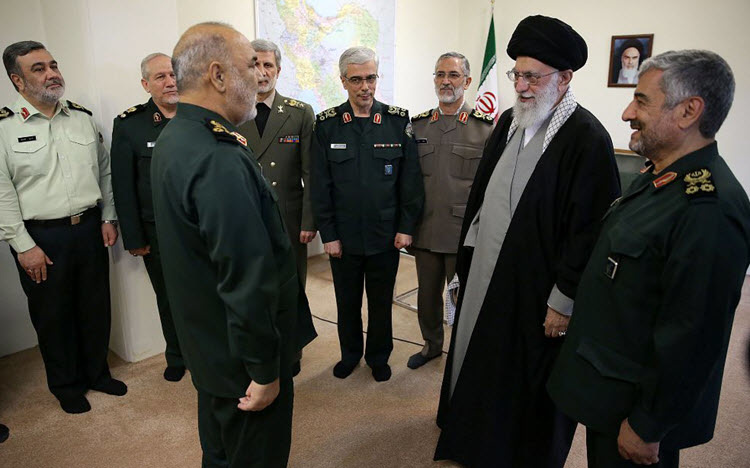New Revolutionary Guards commander-in-chief, Maj. Gen. Hossein Salami, is received by the Supreme Leader and outgoing commander-in-chief Maj. Gen. Mohammad Ali Jafari (R), Tehran, Iran, April 2019
Co-published with The Independent:
Mr Fire and Fury is back. And this time he’s Locked and Loaded.
On Sunday, Donald Trump (or his staff) used their favorite pulpit, Twitter, to respond to the previous day’s drone and missile attacks on two Saudi oil installations, more than halving the Kingdom’s production.
Saudi Arabia oil supply was attacked. There is reason to believe that we know the culprit, are locked and loaded depending on verification, but are waiting to hear from the Kingdom as to who they believe was the cause of this attack, and under what terms we would proceed!
— Donald J. Trump (@realDonaldTrump) September 15, 2019
Of course, while the former star of The Apprentice has often chest-thumped that he’s ready for a missile version of his old show, he tends to hold fire. Just ask North Korea’s Kim Jong-un.
See also TrumpWatch, Day 970: Trump Steps Back on Showdown With Iran Over Saudi Attacks
In late June, Trump was ordering US airstrikes inside Iran, after the country’s Revolutionary Guards downed an American drone near the Strait of Hormuz. But within an hour, he called off the operation, and within days, he returned to his primary objective: a camera-filled meeting where he would shake hands with Iranian President Hassan Rouhani.
That handshake will never happen. The problem for The Donald is that any Iranian official — from Rouhani to Foreign Minister Mohammad Javad Zarif to the staffer making tea at Iran’s UN Mission — is a no-show without the permission of the Islamic Republic’s Supreme Leader. And Ayatollah Khamenei will not budge unless the US withdraws the comprehensive sanctions it imposed last November, six months after Trump tore up the 2015 nuclear deal between Iran and the 5+1 Powers.
So which way do Trump and his advisors swing in the winds of the Persian Gulf? The answer does not lie with them.
Watching the Guards
For that answer, look to the Revolutionary Guards, Iran’s specialist military forces.
Since last year, the challenge for the Iranian regime has been how to regain the initiative from the Trump Administration’s “maximum pressure” seeking to breaking the Islamic Republic’s economy. The efforts of President Rouhani and Foreign Minister Zarif for vital economic links, especially with Europe, have been fruitless. The Supreme Leader has ruled out any direct diplomatic maneuvers with the Americans. He has refused to European calls for negotiations over Iran’s missile program and activities in the Middle East, such as support of Syria’s Bashar al-Assad.
That leaves the option of a quasi-military counter-offensive by the Guards, both against the Americans and against the “weak” Rouhani Government. Inside Iran, the military faction has stepped up the seizure of dual and foreign nationals, including from the US, UK, and Australia, while using its media outlets to jab at the President and Foreign Minister. In the region, its version of “You’re Fired” downed the American drone and may have included attacks on tankers in UAE ports and in the Persian Gulf. On 19 July, it seized the UK-flagged tanker Stena Impero, implementing the Supreme Leader’s command for retaliation after Gibraltar’s impoundment of the Iranian supertanker Adrian Darya 1. (The Adrian Darya was released last month and soon broke Iran’s guarantee that it would not deliver oil to the Assad regime. The Stena Impero is still held in the southern Iranian port of Bandar Abbas.)
Officially it is Yemen’s Houthi insurgency, which controls much of the country, which has claimed responsibility for Saturday’s drone and missile attacks. Unofficially, it is the Revolutionary Guards which have been training and supplying the Houthis as a series of strikes were carried out against Saudi targets this year. And the US is claiming that the latest attacks, as well as some of the earlier ones, came from Iranian-supported forces in Iraq.
Of course, both the Iranian regime and those sceptical of any US Government will note that there is still no conclusive proof of Tehran’s complicity in the attacks on Saudi oil facilities, pumping stations, and airports. They will question any attribution to Iran of tanker attacks in the Strait of Hormuz, putting pressure on the route for 1/5th of the world’s oil supply.
But in a shrewd assessment of US pressure and Iranian counter-pressure, it is the Revolutionary Guards who assume the leading role in Tehran’s response. As Gen. Ali Hajizadeh, the Guards’ air force commander, made clear on Sunday: “In addition to US bases in the region, we have all their vessels, including aircraft carriers and warships, under fire of our missiles to a radius of 2,000 km, and are constantly monitoring them.”
At the very least, the Guards have sunk Trump’s ambition for his photo opportunity.
Mr Fire and Fury is back, and he says he is Locked and Loaded. But the Revolutionary Guards are already on the move, and there is little no precedent for Trump acting on his words.
To paraphrase Joseph Stalin’s quote about the Pope: “How many divisions does a Twitter account have?”


“But Iran’s Revolutionary Guards Hold The Initiative”
IRI has attacked, but is this an enviable position hold? Lets say iri attacks another place, oil prices go up and settle back down, then what? You know what would be a devastating response? Not to get a military response is iri doesn’t know how to handle.